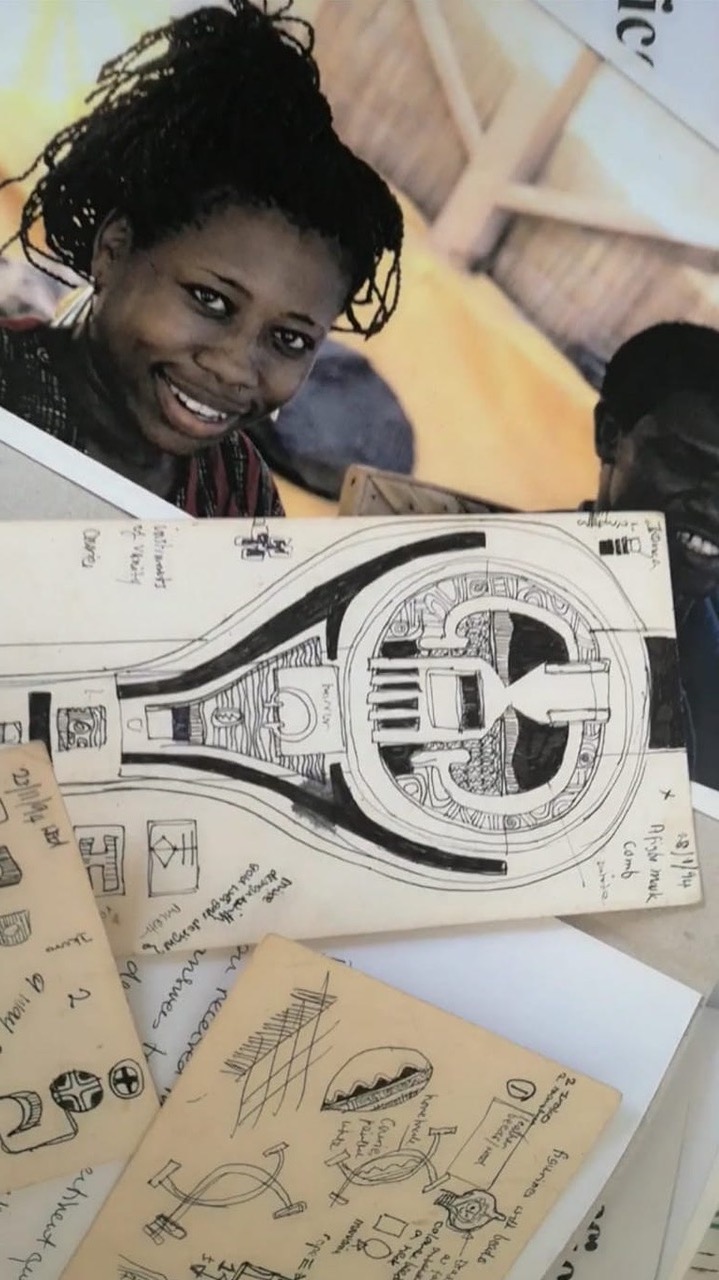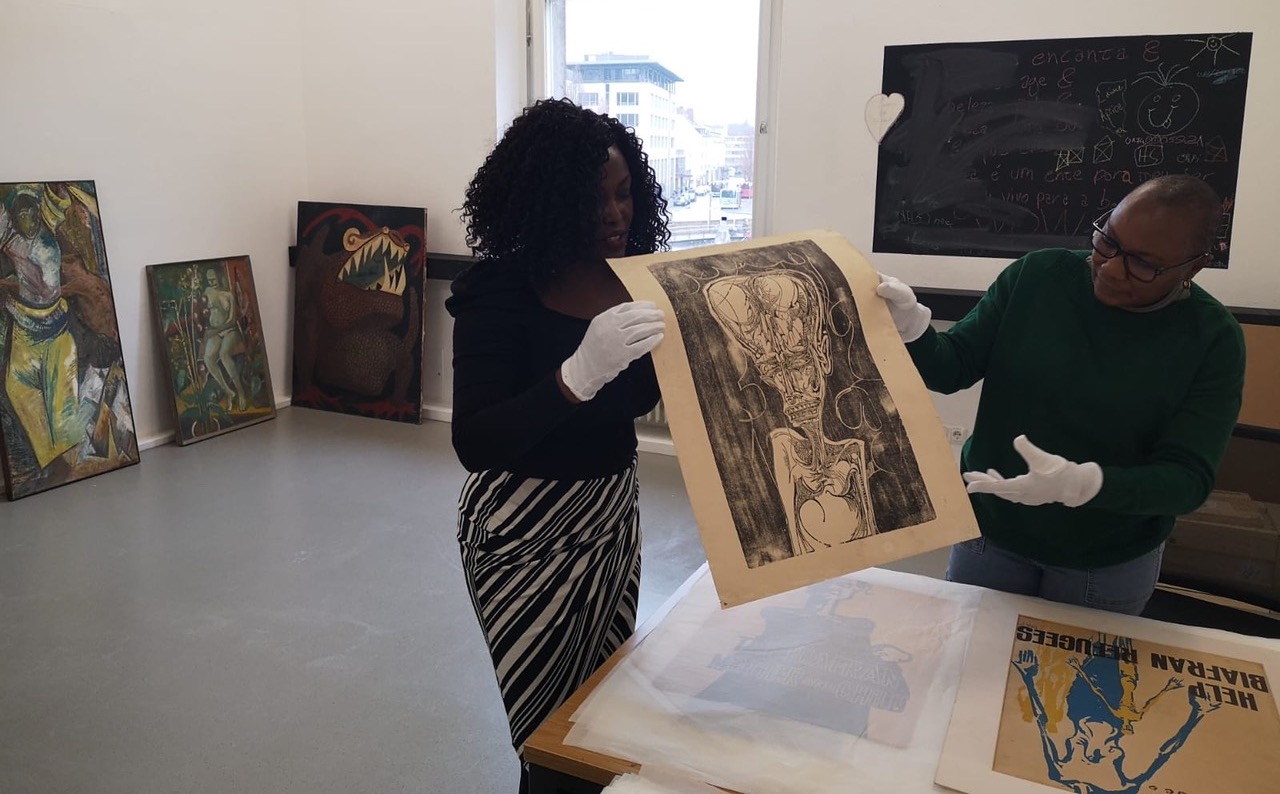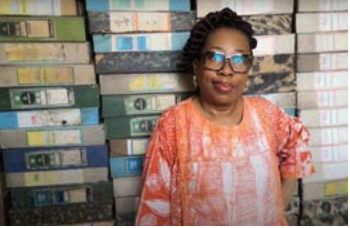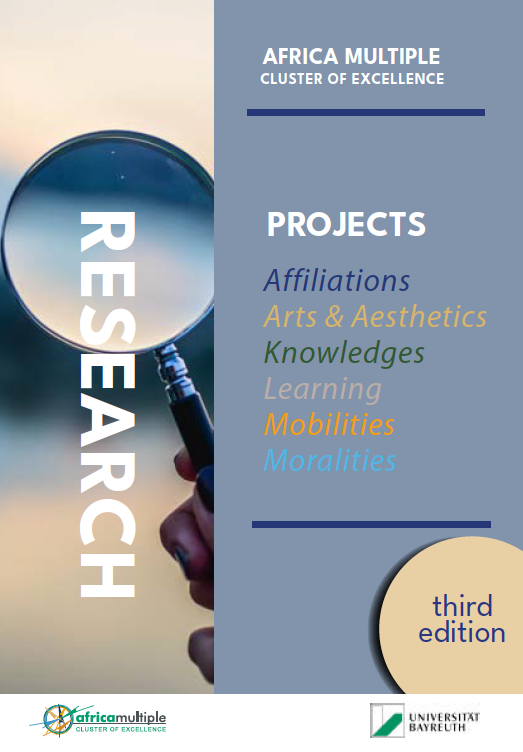Of Art Worlds – Collecting and Archiving Modern and Contemporary Art on the African Continent
-
Research Section: Arts and Aesthetics
-
Project duration: 01.01.2020 - 31.12.2023
Summary
The project is inspired by a perspective of multiplicity that foregrounds art collections and artworks as multi-layered configurations. It aims to look at art collections (on the African continent and, due to the pandemic, here in Germany), by starting analytically with artworks, their formal qualities and what these might bring to light, and exploring the object biographies of each artwork in a collaborative (!) and sensory approach, as all information is linked to the form and histories of the collections and the institutions associated with them. It also helps to question established narratives and one’s owns view on artworks and art worlds in general.
The project builds on the work of previous research projects such as African Art History and the Formation of a Modern Aesthetic: African Modernism in Institutional Art Collections Related to German Collecting Activities, in which the history of modern art is seen as an intertwined history that needs to be considered from a trans-cultural perspective and in which collections are examined as networks, but also through an in-depth analysis of the biographies of singular artworks.
Key Questions
Artworks and collections are the empirical joints for the study of modern and contemporary art. They are not static but change in time and space, they are always relational and multifaceted, which means that the (e.g. economic) aspirations, strategies and desires associated with them are also fluid.
The guiding research questions are: What collections of modern and contemporary art exist where? What is collected by whom, where and why? Who oversees collecting and its afterlife? Why is its digitisation important and for whom? How accessible are the collection? Who are the gatekeepers? How do collections in general inform the art world
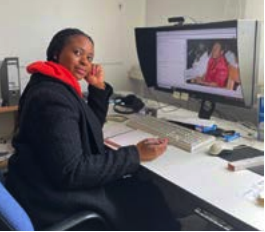
Michelle Nkemakolam scanning and inventorying the archive of Ndidi Dike, 2023. (Photo: Michelle Nkemakolam)
Methods and Concepts
Regardless of how individual artworks are constituted, they are embedded in fluid clusters with further subdivisions. One of the basic assumptions is that the relationality of a given artwork directly influences the understanding of higher-level forms such as the art collection and, subsequently, the notion of art worlds and their respective identities. To understand the characteristics of collections, a collaborative and sensory approach is combined to actually grasp their meanings and possibilities. In three major sub-projects we explored forms of artworks and collections. The first project focused on the artworks of Tijani Mayakiri that were ‘liberated’ from their frames to reveal hidden places and spaces. The idea was to find new ways of caring for and curating modern artworks so that they could be seen, appreciated and understood, while the works themselves could unfold their own agency within a post-colonial production of knowledge. The second project aimed at different medialities of objects and their transformations in the context of the oeuvre of Uche Okeke, one of Nigeria’s most important modern artists. The various processes of media transformation were critically observed, as the creation of digital objects and the corresponding meta-data as well as their embedding in physical and digital infrastructures are not neutral processes but are shaped by where and by whom they are carried out. The third project Onyemaechi focuses on the collection and archive of Ndidi Dike, one of the leading contemporary female artists in Nigeria. Her collection will be indexed and digitized as extensively and completely as possible, and nearly forty years of research data will be made digitally accessible for further research to provide the ultimate overview of the artist’s work. Here the questions arise: What is worth documenting for an artist? What aspects of self-representation are hidden behind this and how does this affect a collection? What collecting strategies does the artist intend and how does this play out in the context of the institutional work of the Iwalewahaus?
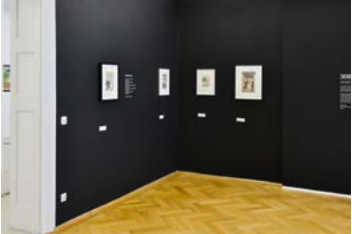
Exhibition ‘We will now go to Kpaazaair – Transitions and journeys through Uche Okeke’s work‘ at Iwalewahaus, 2022. (Photo: Mohamed Elhennawi)
Vision
The project aims to contribute to the understanding of the form of collections and artworks as multiple actors and interests are involved. As most of the team’s researchers are based in Germany, the collaborative approach is crucial in this project and is understood as a decolonizing strategy, a collective process that can open structures to different claims, perspectives, and intentions, and reflects existing, sometimes unquestioned structures and power imbalances. Therefore, all sub-projects revisit the collection of the Iwalewahaus, question its legacy and possible return, and try to keep opening the discourse on their own role and established narratives.
Relation to the Cluster’s Aims & Goals
The research provides in-depth research of the constitution of single collections with a strong focus on women voices (as artists, as researchers, as caretaker of artworks and archives). It also looks at digital spaces, their drawbacks, and the opportunities for researchers in different fields and locations. Again, the collaborative approach is key to questioning the role of white European researchers and their given realities, contributing to further reconfiguration of African Studies.
Project Team
Dr Ulf Vierke
Director Iwalewahaus
Dr Katharina Greven
Project Manager, Researcher
Art Science
University of Bayreuth
Alexandra Kuhnke
Researcher and PHD Student
Art Science
University of Bayreuth
Lena Naumann
PHD Student
Art Science
University of Bayreuth
Michelle Nkemakolam
Student Assistant
University of Bayreuth
Benjamin Zorn
Digital Assistant
University of Bayreuth
Further Links
Find more information on the project here:
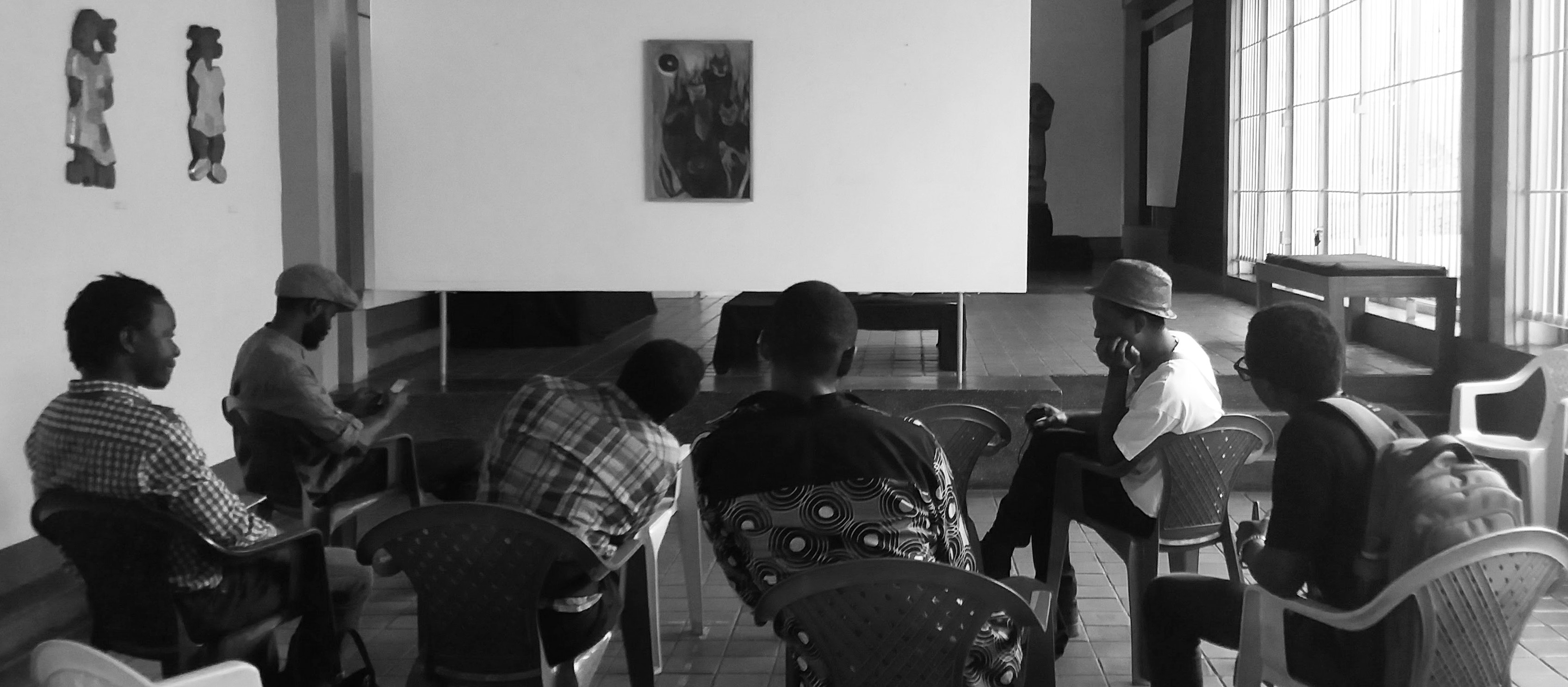
Photo Credit: Martha Kazungu
Summary
The project Of Art Worlds - Collecting and Archiving Modern and Contemporary Art on the African Continent takes its inspiration from a perspective on multiplicity that brings art collections and artworks as multi-layered configurations to the forefront. It aims to look at art collections (on the African continent and also, due to the pandemic, here in Germany), by analytically starting with artworks, its formal qualities and what these might bring to light, exploring the object biographies of each artwork in a sensual and collaborative (!) approach as all of these information are related to the form and histories of the collections and their linked institutions. It also helps to question established narratives and one owns view on artworks and art worlds in general.
Artworks and collections are the empirical joints for the research on modern and contemporary art in Africa, so far mainly focused on history and context rather than on the artwork itself. The project builds up on and follows the work of previous research projects such as African Art History and the Formation of a Modern Aesthetic: African Modernism in Institutional Art Collections Related to German Collecting Activities, where the history of modern art is regarded as an entangled history that requires examination from a trans-cultural perspective and where collections as networks are examined but also by in-depth analysis of the biographies of singular artworks.
The current project is also inspired by new formalist approaches and their renewed attention to form as organizations or arrangements that afford representation and portability across materials and contexts (Levine 2015). Regardless of how specific works of art are constituted, they are embedded within fluid clusters with further dividuations. One of the basic assumptions is that the relationality of a given art work directly informs the understanding of superordinate forms such as the art collection and, subsequently, the notion of art worlds and the respective identities. To understand the very characteristics of collections, e.g. by interpreting them as self-reflexive meta-images in Mitchell’s (2008) sense, a communal and sensual approach is combined to actual grasps its meanings and possibilities.

Insights into the archive of Ndidi Dike, 2021. Photo credit: Lena Naumann
In 2020, a new artwork of Tijani Mayakiri arrived at the Iwalewahaus. An exhibition was shown with 34 works, which were attributed to Tijani Mayakiri. His paper work was shown in an unframed way, realizing that more was achieved than simply revealing the back of the work. It seemed that the paper work was freed from its frames, seeing it as a three-dimensional haptic object, which seems obvious but not always present on one’s mind. Most importantly the frame, the Bildrand, came to the forefront and revealed hidden places and spaces. By ‘deframing’ the art work not only in a literal but also abstract sense, given perspectives on the art work and ultimately the collection itself were questioned. The idea was to find new ways of caring for and curating the modern artworks to be able to see them, value them and understand them, while the works themself are able to unfold their own agency within a post-colonial knowledge production. To question existing relationalities, the form had to be regarded first (here an individualistic artwork) in order to allow its meaning(s) to crystallize.
Another large project, which recently unfolded in the comprehensive exhibition We will now go to Kpaaza’, targets at different medialities of objects and its transformations related to the oeuvre of Uche Okeke, one of Nigeria's most important modern artists, who significantly shaped one concept of Nigerian modernism(s).
The physical objects of the Iwalewahaus collection and the Asele Institute in Nigeria came together in a curatorial project situated at Iwalewahaus. Whilst the objects of the collection in Bayreuth are already available in a digital form, those from Nigeria will only partly be processed digitally in Bayreuth. The question is how this process is going to be shaped? Who is processing? How do the results look like? How important are newly created digital spaces in reconfiguring African Studies in general and art studies in specific. How can the digital space actual be seen as a post-colonial space that criticizes given roles and perspectives? The objects are addressed in different forms: physical objects situated in the Global North and those in the Global South and the equivalent set of data objects and their respective metadata.
While the works from Asele are in Bayreuth (which is currently the case), the various processes of media transformation will be critically observed, as the creation of digital objects and the respective meta-data as well as their embedding in physical and digital infrastructures (collections, databases) are not neutral processes but coined by where and by whom it is done. On the digital WissKI-platform (so far a set of ten images in online) a set of researchers, among others Ijeoma Uche-Okeke, South-Africa-based academic researcher and Nantume Violet, Ugandan-based artistic and curatorial researcher, are contributing with their expertise and various accesses to the given set of objects and existing ontologies.

Nantume Violet and Ijeome Uche-Okeke at the Iwalewahaus, 2022. Photo credit: Lena Naumann
The project Onyemaechi focuses on the collection and archive of Ndidi Dike, one of the leading contemporary female artists in Nigeria. Her collection will be indexed and digitized as extensively and completely as possible, and the research data, images and interviews, collected newspaper articles in a career spanning almost forty years will be made digitally accessible for research that provides the ultimate overview of the artist's work. Already in May, Dike, her assistant Taiwo Aiyedogbon and the researcher Lena Naumann, on the ground in Lagos began documenting her collection in images and video, creating interviews that will then be processed by the Bayreuth team. A transfer of the material into the easyDB database with a link to the collection page of the Iwalewahaus is aimed at and will serve as a basis for the research. A digital working platform in WissKI is also created as a space of shared knowledge production and interconnections between artworks worldwide.
Ndidi Dike's project thus again shows another perspective on Art Worlds: What is considered worthy of documentation for the artist? What aspects of self-representation are hidden behind this and how does this affect a collection? What collecting strategies does the artist herself intend and how does this collaborate in the context of the institutional work of Iwalewahaus?
Furthermore, Ndidi Dike's oeuvre raises questions that reflect the mapping of materiality and form: Dike produces predominantly expansive installations that require specific technical requirements in their capture. How can materiality and form as haptic requirements be mapped and represented in the digital world? What possibilities of a sensual experience does the digital still offer us? Furthermore, Dike's position within the project is a special one: in addition to her role as an artist, she also assumes the perspective of a researcher who examines her own artistic production and critically questions notions about the archive and collections.
The collaborative approach in this project is crucial and is understood as a decolonizing strategy, a collective process that can open structures to different demands, perspectives and intentions, and reflectively look at existing, sometimes unquestioned structures and power imbalances. Therefore, in all of the sub-projects, the collection of the Iwalewahaus will be revisited, questioning its legacy and trying to constantly open up the discourse about one’s own role and established narratives.


